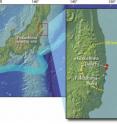Scientists assess radioactivity in the ocean from Japan nuclear power facility
With current news of additional radioactive leaks from the Fukushima nuclear power plants, the impact on the ocean of releases of radioactivity from the plants remains unclear. But a new study by U.S. and Japanese researchers analyzes the levels of radioactivity discharged in the first four months after the accident.
It draws some basic conclusions about the history of contaminant releases to the ocean.
The study was conducted by Woods Hole Oceanographic Institution chemist Ken Buesseler and two colleagues based in Japan, Michio Aoyama of the Meteorological Research Institute and Masao Fukasawa of the Japan Agency for Marine-Earth Science and Technology.
They report that discharges from the Fukushima Dai-Ichi nuclear power plants peaked one month after the March 11 earthquake and tsunami that precipitated the nuclear accident, and continued through at least July.
Their study finds that the levels of radioactivity, while high, are not a direct threat to humans or marine life, but cautions that the effect of accumulated radionuclides in marine sediments is poorly known.
The release of radioactivity from Fukushima--both as atmospheric fallout and direct discharges to the ocean--represents the largest accidental release of radiation to the ocean in history.
Concentrations of cesium-137, a radioactive isotope with a 30-year half-life, at the plants' discharge points to the ocean peaked at more than 50 million times normal/previous levels.
Concentrations 18 miles offshore were higher than those measured in the ocean after the Chernobyl accident 25 years ago.
This is largely related to the fact, says Buesseler, that the Fukushima nuclear power plants are located along the coast, whereas Chernobyl was several hundred miles from the nearest salt water basins, the Baltic and Black Seas.
However, due to ocean mixing processes, the levels are rapidly diluted off the northwest coast of Japan.
The study used data on the concentrations of cesium-137, cesium-134 and iodine-131 as a basis to compare the levels of radionuclides released into the ocean with known levels in the sea surrounding Japan prior to the accident.
The resulting paper, Impacts of the Fukushima Nuclear Power Plants on Marine Radioactivity, is published in the current issue of the journal Environmental Science & Technology.
Buesseler was awarded a rapid-response grant from the National Science Foundation's (NSF) Division of Ocean Sciences to establish baseline concentrations of radionuclides in the Atlantic and Pacific Oceans.
"Understanding and management of the long-term geochemical fate and ecological consequences of radiochemical contamination of the sea is dependent on our knowledge of the initial conditions," says Don Rice, director of NSF's Chemical Oceanography Program. "Acquiring that knowledge depends on our ability to deploy experts to the scene with minimal delay."
The investigators compiled and analyzed data on concentrations of cesium and iodine in ocean water near the plants' discharge points.
The data were made public by TEPCO, the electric utility that owns the plants, and the Japanese Ministry of Culture, Sports, Science and Technology.
The team found that releases to the ocean peaked in April, a fact they attribute to "the complicated pattern of discharge of seawater and freshwater used to cool the reactors and spent fuel rods, interactions with groundwater, and intentional and unintentional releases of mixed radioactive material from the reactor facility."
The scientists also found that the releases decreased in May by a factor of 1,000, "a consequence of ocean mixing and a primary radionuclide source that had dramatically abated," they report.
While concentrations of some radionuclides continued to decrease, by July they were still 10,000 times higher than levels measured in 2010 off the coast of Japan.
This indicates that the plants "remain a significant source of contamination to the coastal waters off Japan," the researchers report.
"There is currently no data that allow us to distinguish between several possible sources of continued releases," says Buesseler.
"These most likely include some combination of direct releases from the reactors, or storage tanks or indirect releases from groundwater beneath the reactors or coastal sediments, both of which are likely contaminated from the period of maximum releases."
Buesseler says that at levels indicated by these data, the releases are not likely to be a direct threat to humans or marine biota in the surrounding ocean waters.
There could be an issue, however, if the source remains high and radiation accumulates in marine sediments.
"We don't know how this might affect benthic marine life, and with a half-life of 30 years, any cesium-137 accumulating in sediments or groundwater could be a concern for decades to come," he says.
While international collaborations for comprehensive field measurements to determine the full range of radioactive isotopes released are underway, says Buesseler, it will take some time before results are available to fully evaluate the impacts of this accident on the ocean.
The Gordon and Betty Moore Foundation also funded the research.
Source: National Science Foundation
Other sources
- Japan Says Stricken Nuclear Power Plant in Cold Shutdownfrom Scientific AmericanFri, 16 Dec 2011, 18:00:37 UTC
- Japan declares Fukushima stablefrom BBC News: Science & NatureFri, 16 Dec 2011, 9:04:57 UTC
- News Analysis: Japan Set to Declare Control Over Damaged Nuclear Reactorsfrom NY Times ScienceThu, 15 Dec 2011, 5:40:16 UTC
- Japan minister questions radioactive water dumpfrom PhysorgTue, 13 Dec 2011, 21:31:33 UTC
- Scientists assess radioactivity in the ocean from Japan nuclear power facilityfrom Biology News NetSun, 11 Dec 2011, 23:30:15 UTC
- Radioactive water leaked at second Japan plantfrom PhysorgSun, 11 Dec 2011, 8:30:36 UTC
- Scientists assess radioactivity in the ocean from Japan nuclear power facilityfrom Science DailySat, 10 Dec 2011, 1:30:21 UTC
- Japan plant operator mulls new nuclear water dumpfrom PhysorgThu, 8 Dec 2011, 18:30:52 UTC
